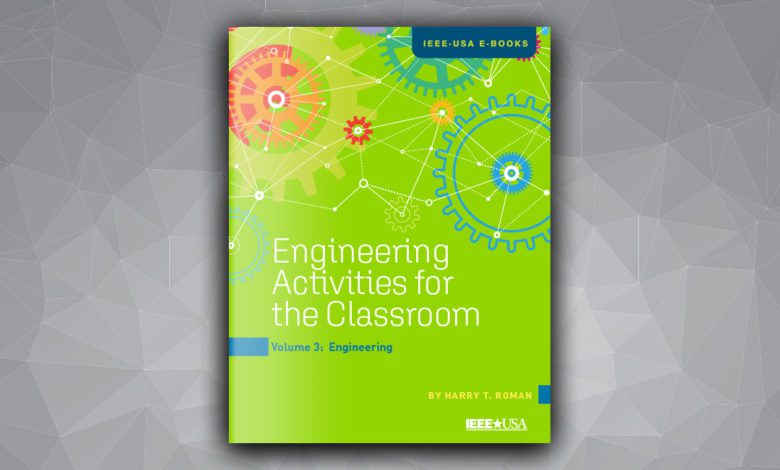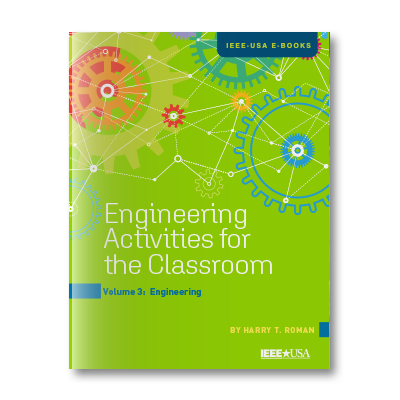

Engineering Activities for the Classroom – Volume 3: Engineering
FREE to Members
Non-Members: $2.99
The great American author Henry James once said: “A teacher affects eternity; he can never tell where his influence stops.” Harry Roman, the author of dozens of IEEE-USA books, understands the value of teaching, and especially of teaching STEM to children. His love of engineering and an extreme desire to ignite a passion for engineering in future generations comes through in every book — but especially in his new IEEE-USA e-book, Engineering Activities for the Classroom – Volume 3: Engineering. In this book, Roman draws on his 50 years as an engineer, and countless hours teaching students, as he offers up a steady stream of activities, project ideas and discussion topics for teachers to use with students from kindergarten to high school.
IEEE-USA is offering Engineering Activities for the Classroom – Volume 3: Engineering, free to all IEEE members. Non-members pay $2.99. The book is available from the IEEE-USA Shop. This book is ideal for sparking ideas in the seasoned teacher, or for the engineer that has been asked to do a guest lesson at their child’s school or club — or for a parent looking for ideas to spend a rainy day fostering an interest in engineering in their own child.
In Volume 3, Roman encourages teachers to engage their students in the world around them through exercises such as reengineering the entrance way to their school; or imagining their school empty and abandoned — how would they repurpose it? For apartments? A maker space? Or maybe as an incubator for startup companies? He also encourages teachers to lead a discussion on which animals or insects would make the best engineers. For older students, Roman suggests taking them to visit a local town council meeting, where engineers discuss plans for a new facility or redevelopment. He suggests having them observe what kinds of concerns attendees raise, and experience how the engineers build such concerns into their plans and designs.
Roman also suggests sparking an interest in engineering by delving into history, recommending teachers challenge their students to discover the five U.S. presidents who were engineers (hint: land surveying was considered part of the engineering field); identify the Eight Wonders of the Ancient World — discuss how they were engineered, and how they compare to engineering feats of today; or, encourage students to nominate engineers from their state for an Engineering Hall of Fame.
Roman’s suggestions often draw from his own passion for clean energy, or Thomas Edison, even suggesting a debate: was Thomas Edison an engineer — or was he a scientist or an inventor?
The author’s passion for engineering comes through on every page, and he offers several activities to, as he says, “get young students thinking about our incredible profession.” He suggests teachers challenge students to use the internet to discover the first engineering school in the United States; the requirements for getting into an engineering program; what courses are offered; and what fields of engineering one can major in; or to identify the average starting salary of an engineer in various fields, comparing it to other professions.
For higher-level students, Roman offers a series of activities teachers can use for stimulating classroom discussion such as:
- A large wind turbine installation to be installed off the coast of New Jersey occupying many square miles of ocean area — and discussing the economic, environmental, social, legal, regulatory, aesthetic, and cultural impacts of such a massive installation.
- Your company has just installed a large photovoltaic system on a two-story school. Some students have been throwing stones and damaged a number of the solar panels. As the design engineer for the project, how might you remedy this problem?
- Study the science, technology and engineering of paints. When did paints first come into large-scale use for surfaces and selected items? How did the colors for the original paints come about? How are paints tested for their application and durability?
- Engineers are creating micro-miniature sensors, which some have termed “smart dust.” These devices can be dispersed throughout materials, or into the environment. Where do your students think this smart dust might be deployed? Are there precautions that should be taken to make sure this dust is not harmful?
These are just a taste of the many ideas Roman offers up. This e-book is the third in a five-book series with different engineering activities for the classroom. The first two IEEE-USA e-books in the series are Engineering Activities for the Classroom – Volume 1: Telecommunications and Computers and Engineering Activities for the Classroom – Volume 2: Energy in Our World. Completing the series, and to come, will be two more e-books covering activities related to Robotics, as well as Invention and Entrepreneurship. All of the publications are free for IEEE members at https://ieeeusa.org/shop/.
Paul Lief Rosengren is the coauthor of In the Time of Covid: One Hospital’s Struggles and Triumphs. He worked for more than three decades in communications at NBC, PSE&G, and in state government. Rosengren has a Master’s in Public Policy from The Kennedy School of Government, Harvard; and an undergraduate degree in political science from Dickinson College.






